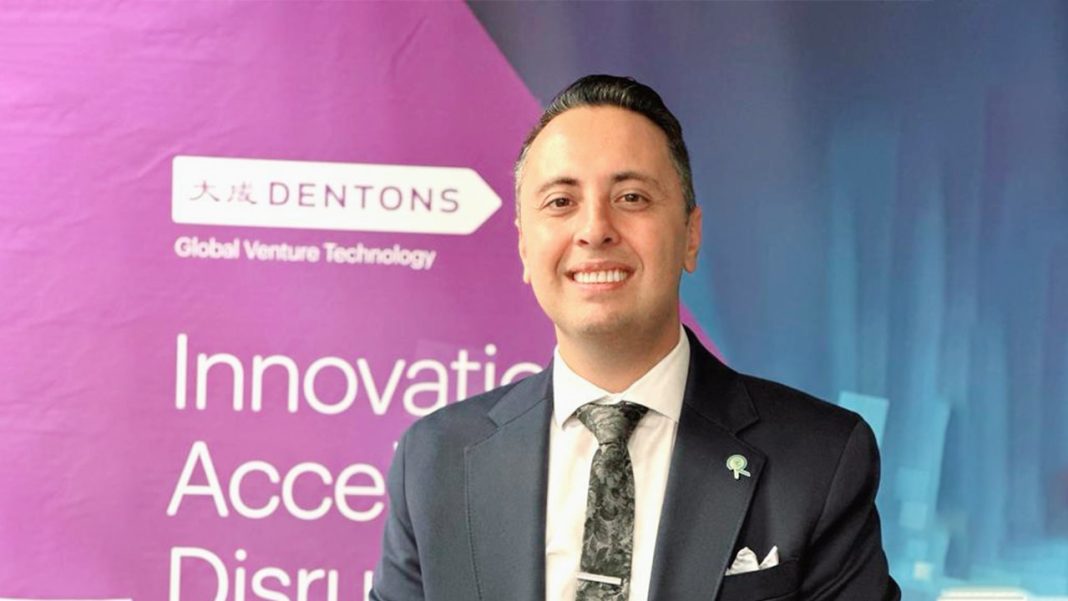James Anthony Wolff, a seasoned senior associate at Sobel Pevzner LLC, United Nations Association board member, and senior advisor at IgniteGTM, recently shed light on the role of emerging technologies like blockchain in promoting sustainability. In a captivating speech as a focus presenter for the Future of Climate Summit in New York City, as part of the United Nations General Assembly Week side-events, he discussed how blockchain can drive innovative solutions for sustainable cities and rural revitalization, ultimately aligning with the 2030 Sustainable Development Goals. The Summit took place at the law firm of Dentons in Midtown Manhattan on September 15, 2023, it was hosted by PDIE, Purpose Driven Innovation Group, and Sublime Communications. Its partners included The Earthshot Prize, Planet Positive 2030, IEEE Standards Association, WhatIf Foods, and more. The Summit brings together change makers, entrepreneurs, corporates, investors, and governments to co-create a better tomorrow through sustainable innovation.
Blockchain: The Catalyst for Sustainable Cities
Wolff introduced the audience to Qbix’s innovative product—Intercoin—a global currency platform that enables local communities to issue their own digital currencies. Unlike popular cryptocurrencies such as Bitcoin and Ethereum, Intercoin is designed with scalability and security in mind, specifically targeting the unique needs of localized economies. It boasts an array of features tailored for urban sustainability, including applications for voluntary basic income, transparent electoral processes, and robust governance mechanisms. Thus, Intercoin serves as a technological nexus for fostering transparent administrative actions, public expenditures, and electoral outcomes. The architecture employs an immutable, publicly accessible ledger, catalyzing a radical shift in the citizen-government dynamic.
Reinventing Urban Governance Through Transparency
Wolff went on to explain that Qbix had developed Intercoin, a global currency platform allowing communities to issue their own currency. Unlike Bitcoin and Ethereum, Intercoin is designed to be secure and scalable, tailoring fintech solutions to the needs of local communities. With features like voluntary basic income applications, transparent elections, and governance capabilities, Intercoin aims to revolutionize the concept of sustainable cities. Blockchain technology in urban centers could be the lynchpin for economic stability, social equality, and transparent governance. It enables cities to experiment with novel methods of sustainability, such as urban farming or waste reduction initiatives, and build them into the fabric of their administration and economy.
Economic Stability Through Localized Currency Systems
At the foundation of any sustainable urban environment lies effective governance, a principle intrinsically linked to transparency. Consider a scenario in which every administrative action, public expenditure, and electoral outcome is indelibly recorded on a publicly accessible, immutable ledger. This is the exact functionality that the Intercoin platform by Qbix endeavors to bring to fruition. Utilizing blockchain technology to facilitate transparent elections and governance mechanisms, Intercoin significantly alters the paradigm of citizen-government interactions. Wolff reasoned that such transparency engenders trust, assures accountability, and stimulates civic engagement, thereby contributing to an overarching momentum toward sustainable urban development.
Wolff clarified that, in contrast to global cryptocurrencies like Bitcoin and Ethereum that are vulnerable to the fluctuations of international markets, a localized digital currency can be customized to align with the distinct financial objectives and necessities of a particular community. This community-centric approach provides a stable economic groundwork that allows for sustainable urban development. It facilitates targeted investments in eco-friendly infrastructure, renewable energy sources, and local enterprises that adhere to Environmental, Social, and Governance (ESG) standards.
Social Equality Through Voluntary Basic Income
Wolff elaborated on how this transformative technology could also address social inequities that plague modern cities. Through features like voluntary basic income—built directly into the Intercoin platform—blockchain technology can provide a practical framework to ensure even the least privileged have access to essential services. This is more than just social welfare; it’s a revolutionary step towards creating inclusive cities where sustainable living opportunities are universally accessible. This approach could significantly mitigate poverty, reduce crime rates, and bolster community well-being.
But the relevance of blockchain extends beyond governance and economics. Wolff underscored its potential as the underlying technology for other facets of urban sustainability. Whether it’s tracking waste from origin to disposal or issuing renewable energy credits, blockchain’s immutable and transparent nature can provide the accountability needed to make these initiatives more effective. The technology enables cities to incorporate experimental sustainability methods—such as urban farming or waste reduction programs—directly into their administrative and economic frameworks. These aren’t peripheral initiatives but integral components of what could be a new standard for urban living.
Sustainability as an Integral Part of Urban Life
Wolff also posited that the blockchain can also serve as a backbone for other sustainability initiatives in cities, ranging from waste management to energy consumption. Imagine a city where blockchain tracks waste from its origin to its disposal, ensuring responsible recycling or decomposition. Or consider an energy grid where renewable energy credits are issued via blockchain, promoting a move away from fossil fuels. By enabling a high level of transparency and accountability, blockchain allows cities to experiment with novel sustainability methods like urban farming or waste reduction initiatives. These aren’t merely pilot programs but can be woven into the very fabric of urban administration and economy, making sustainability a natural part of city life.
In summary, Wolff passionately explained that blockchain technology isn’t just a trendy buzzword; it holds tangible promise for making cities more sustainable, equitable, and livable. Through enhanced governance, economic stability, social equality, and experimental sustainability initiatives, platforms like Intercoin are pioneering a new form of urban life that could very well set the standard for future cities. As we strive for more sustainable urban living aligned with ESG principles, blockchain emerges not merely as an enabler but as a catalyst for profound change.
Rural Revitalization Through Distributed Ledger Technology
Rural areas are frequently neglected in conversations about sustainability, yet they play an essential role in sequestering carbon and preserving biodiversity. Wolff introduced us to Blockchain Laboratories and their work on Carbonland Trust’s DLT carbon credit registry, which employs Distributed Ledger Technology (DLT) to offer economic benefits from forest conservation to rural areas. Rural landscapes are often overlooked in discussions surrounding sustainability, and landowners with forests often have only logging as a way to benefit economically, even though their forests are crucial in carbon sequestration and biodiversity preservation. Wolff brought attention to this gap by introducing Blockchain Laboratories and their groundbreaking work on Carbonland Trust, a climate solution that employs Distributed Ledger Technology (DLT) to foster rural sustainability.
Financial Incentives for Conservation
Carbonland Trust carbon credit tokenization platform provides an innovative avenue for forest owners, particularly those with small acreages, to engage in the voluntary carbon market. Instead of opting for deforestation as a means of economic sustenance, landowners can now monetize their conservation efforts. They have the capability to issue carbon credits for the forest land they protect, thus creating a financial impetus for engaging in sustainable practices. This model presents a powerful mechanism for invigorating rural economies, transforming sustainable agriculture and forestry from ecologically responsible choices into economically feasible ones. The Carbonland Trust Carbon Credit Registry provides forest owners with access to the voluntary carbon markets, enabling them to monetize conservation efforts rather than resorting to deforestation. Small-acreage landowners can issue carbon credits for their protected forest land, adding a financial incentive to sustainable practices like protecting biodiversity and creating pollinator habitat. This move can revitalize rural economies by making sustainable agriculture and forestry not just ecologically responsible but economically viable.
By using DLT and tokenization, Carbonland Trust ensures transparency, accountability, and liquidity in their carbon credits. Wolff passionately proclaimed that this approach could fundamentally change the way we approach rural sustainability and conservation efforts.
Distributed Ledger Technology: A Game-Changer for Rural Sustainability
The program employs Distributed Ledger Technology and tokenization processes to bring about a new level of transparency, accountability, and liquidity in the carbon credit market. By ensuring that transactions are publicly recorded and verifiable, DLT provides both landowners and carbon credit purchasers with an unprecedented level of trust in the system. This eliminates traditional obstacles like bureaucratic inefficiencies and opaqueness often associated with environmental credit trading.
Wolff suggested that by leveraging blockchain and Distributed Ledger Technology, Carbonland Trust’s carbon credit program could fundamentally transform our understanding and methods of rural sustainability and conservation. By establishing a system that is both transparent and financially advantageous, the program not only encourages the safeguarding of rural areas but also their sustainable growth by providing economic incentive. Consequently, it introduces a holistic, transparent, and economically sustainable model for the preservation of rural environments by preserving biodiversity and establishing pollinator habitat, thereby addressing a significant void in the broader efforts toward global sustainability.
The Synergy of Urban and Rural Sustainability
Wolff’s overarching message is clear: urban and rural sustainability are two sides of the same coin. While cities serve as testbeds for large-scale sustainable practices, rural areas offer the natural resources and ecosystems that these cities rely on. One cannot thrive without the other, and blockchain technology has the potential to support both in a synergistic relationship.
Wolff advocates for unprecedented collaboration between governments, industries, NGOs, and local communities. Whether it’s incentivizing green technologies, investing in R&D, or promoting sustainable land use, the need for a holistic strategy is more urgent than ever.
Conclusion
The stakes have never been higher in the fight against climate change, but emerging technologies like blockchain offer a glimmer of hope. By creating more sustainable cities and revitalizing rural areas, we can aspire to a resilient, equitable, and environmentally responsible world. In the words of James Anthony Wolff, the path forward lies in leveraging technology to achieve a sustainable synergy between urban and rural environments. As we edge closer to the UN’s 2030 Sustainable Development Goals, this synergy is not just desirable; it’s essential.



















